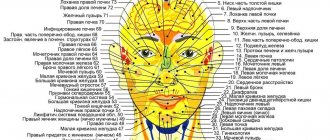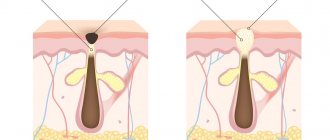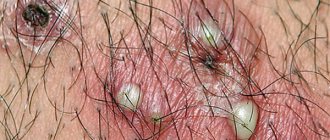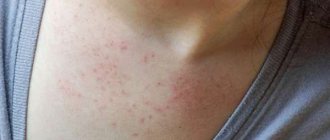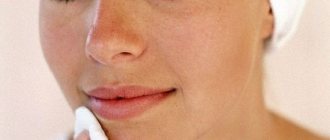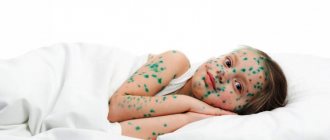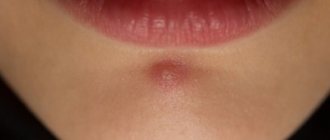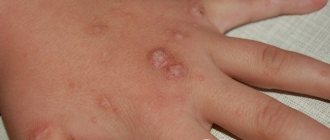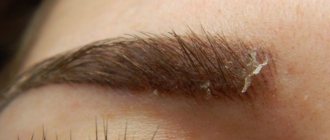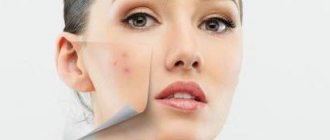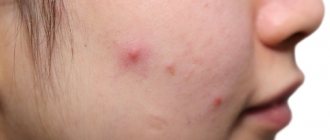Skin rashes often occur not only in the face, but also in other parts of the body, both in women and men. For example, acne on the thighs can indicate a number of serious diseases that can lead to inflammatory processes in the skin. Before starting treatment, the causes of the skin problem should be determined.
Pimples on thighs should not be ignored
Increased sweating
One of the main factors that cause acne to appear on the inner thigh is excessive sweating. Most often, this is caused by incorrectly selected clothing: synthetic fabrics, in contact with hot and damp skin, cause irritation, which quickly turns into small pimples. Often accompanied by itching.
Increased sweating is a constant companion of the hot season. In the summer, in order to prevent irritation, it is enough to replace synthetic clothing with things made from natural materials. Women should opt for loose skirts and dresses: the less the fabric is in contact with the skin, the less likely the appearance of pimples becomes. In this regard, it is somewhat more difficult for men: trousers and shorts come into contact with the skin. Loose clothing made from natural fabric reduces the likelihood of red bumps, which later turn into pimples.
Prevention
It is better to prevent a disease than to treat it. Basically, all preventive measures are based on traditional medicine.
In any case, to prevent the appearance of a rash on the buttocks, you do not need to use various medications. It is enough to adhere to the following simple rules:
- Compliance with personal hygiene rules. Most skin diseases are the cause of human untidiness. Delicate places such as the buttocks and genital areas require special care. To make water procedures not only useful, but also pleasant, you will need medicinal herbs. Add chamomile, celandine and string to the bath. Extend the procedure for at least half an hour. After this, take a shower using your usual personal hygiene products. The procedure can be used when there are already rashes on the body. Medicinal herbs have a beneficial effect on the skin and promote rapid healing of inflammatory processes.
- If the buttock area is excessively sweaty, you can use baby powder.
- Choose underwear made from natural materials. Synthetics provoke allergies, and this will lead to more serious consequences than a rash and pimples on the butt. Women with sensitive skin are not recommended to wear thongs.
Skin diseases: psoriasis, eczema and folliculitis
Sometimes a rash, initially similar to irritation, appears on the back of the thigh or on the inside of the legs due to the development of quite serious skin diseases. These include:
- Psoriasis. Small red pimples, which over time turn into an itchy spot covered with scales, are an undoubted sign of such a disease. Scientists have not yet been able to find out what exactly causes it.
- Eczema. Dense formations filled with clear liquid are a sign of eczema. The disease is divided into several types: scaly, wet or dry.
- Folliculitis. Infectious damage to the hair follicles is one of the factors in the appearance of rashes. In this case, they take the form of large red pimples, inside of which pus accumulates. Accompanied by pain in the affected areas and itching.
If you notice obvious symptoms of skin diseases, you should immediately visit a dermatologist. It is quite difficult to get rid of them without consulting a specialist.
Types of rash
Women are more likely to experience such a problem as a rash on the buttock. Because their skin is soft and sensitive compared to men. In this area, the subcutaneous fat layer of the fair sex is better developed and contains more sebaceous glands. Rashes are usually divided into:
- Ordinary (pigment) spots. They affect the superficial layers of the epidermis. The color range ranges from white to dark brown. The most common is a red rash on the butt in an adult. In one-year-old children, it resembles diaper rash.
- Watery blisters (vesicles). They are small formations of a rough structure protruding above the surface of the skin. Interstitial fluid accumulates in such bubbles as a result of constant friction against clothing.
- Pustules. The initial element of the rash, which has a cavity filled with pus. Such formations are otherwise called pustules. Erupted pustules can affect both the superficial and deep layers of the skin.
- Peeling scales. These are secondary elements of the skin. Dead cells are layered on top of each other - this is how scales are formed. In dermatology, this skin disease is called psoriasis.
- Red nodular lesions (papules). This is a dense formation that slightly rises above the skin. According to the classification, it belongs to inflammatory pimples. Compared to other rashes on the buttocks, they are very painful and constantly itch.
Hygiene and use of cosmetics
If acne appears on the lower extremities, and no causes of pathology are found in the body, it is worth thinking about external influences that cause harm to the skin. Red itchy spots and rashes may appear due to cosmetic products. Fatty creams, clogging pores, interfere with normal metabolism, resulting in the appearance of pimples.
Some components included in shower gels can cause imperfections.
Insufficient hygiene is also one of the causes of rashes. Dirt clogs pores and interferes with the normal functioning of the sebaceous glands. The skin signals this in the only possible way.
Why they appear on the butt: causes of inflammation
Acne on the buttocks in women can appear for various reasons. These can rightly include:
- Hypothermia. Most often, it is caused by wearing clothes that are not selected for the season.
- Lack of certain vitamins in the body, including A, B. Most often observed in women in the off-season.
- Failure to comply with personal hygiene rules. Passive lifestyle.
- Wearing excessively tight clothing: leggings, jeans, tight tights, some types of underwear. Products made from cheap synthetic fabrics are especially likely to cause acne.
- Pregnancy. In this case, acne is a consequence of hormonal changes in the body, dehydration, and toxicosis.
- Increased sweating. Most often, this problem bothers women during training.
- Allergic reactions. It may occur when using certain medications, as well as body care products.
- Poor nutrition. The predominance of fatty, fried foods, as well as fast food in the diet.
Allergic reaction
Before looking for signs of serious skin diseases, updating your wardrobe or purchasing new cosmetics, you should make sure that you do not have a food allergy. One of the symptoms of this condition is skin rashes that occur in various parts of the body.
Until the product containing the allergen is eliminated from the diet, the rash on the thighs will not disappear.
Not only that, but acne can quickly spread throughout the body. The only way out is to visit an allergist and get tested to identify the substance that causes the rash.
Mitigation
Skin requires care, and now there are a sufficient number of products that are created specifically to soften and moisturize. Body creams are in great demand and are quite effective.
An alternative is baby cream and oil. After shaving skin care products are also suitable. Another option could be a face cream that you didn’t like for some reason. Why keep it in a drawer or throw it away when you can put it to great use. The main thing to remember is to make sure that the expiration date has not yet expired.
You should not use expired creams, oils and balms, as poor-quality products can cause even more acne.
Hormonal disbalance
Hormonal instability is usually accompanied by the appearance of acne. Inflammations most often occur on the face, but it does not exclude other parts of the body. This phenomenon is a variant of the norm only in adolescents: during puberty, the overwhelming majority of young people and girls become covered with acne and acne.
Adults should sound the alarm when hormone levels destabilize: perhaps the body is sending signals in the form of acne due to the development of a serious pathology.
Dermatoses
The most common dermatoses are:
- Pityriasis rosea - occurs against the background of hypothermia, decreased immunity in young men, and is not contagious. Pink-red spots appear mainly in autumn and winter and are moderately itchy. The disease goes away on its own.
- Lichen planus - develops due to a genetic predisposition against the background of weakened immunity. Red plaques and sores are very itchy. Small ones pop up around large fires.
- Psoriasis is a hereditary autoimmune pathology, which is characterized by the appearance of red plaques covered with silvery scales and peeling.
The cause of the red spots may be allergic dermatitis, which appears immediately after contact with the irritant. These are synthetic underwear, hygiene products, washing powder, perfumes. The rashes itch, peel, and occasionally become covered with erosions and papules. The disease is complicated by eczema, so the allergen should be identified as soon as possible.
Parasites and various diseases
Pimples on the thighs are rarely caused by a special type of mite - demodex. Their habitat is the skin. It is quite easy to notice traces of the presence of the parasite: when it is present, thin reddish paths are clearly visible on the dermis.
A skin rash is also a sign of some diseases, the vast majority of them are infectious:
- chickenpox;
- measles;
- scarlet fever;
- herpes;
- measles rubella;
- pyoderma.
Only a doctor can determine the exact cause of acne and prescribe the necessary therapy.
Preventive measures
Knowing why acne appears, you can take some measures that can prevent such developments. Of course, in the case of serious diseases it is difficult to take care of prevention in advance, but some simple actions will help avoid rashes in less severe cases:
- Replace rough items made from synthetic materials with a wardrobe made from natural fabrics.
- Eat a healthy diet and eliminate junk foods from your diet.
- Consult with an allergist, take tests and find out which foods may cause reactions.
- Try to minimize stress.
- Maintain good hygiene.
Simple tips will help prevent unsightly rashes on the outer and inner buttocks.
How to get rid of acne on thighs
If acne does appear on the thighs, you should immediately begin to correct the situation. You need to start by consulting a dermatologist, but many manifestations of imperfections can be completely eliminated at home, without resorting to medical help.
Traditional medicine and cosmetology
First of all, you need to start with the selection of cosmetics for comprehensive skin care. Tar soap is suitable for relieving inflammation. It has a pungent odor, but helps quickly dry out areas and reduce redness.
The next step is to moisturize the skin. Baby oil is the most suitable: if it does not harm the delicate skin of babies, then adults definitely should not be afraid of negative consequences. In addition, baby oil is almost completely free of aromatic fragrances and other harmful chemical components.
If cosmetics do not help get rid of the problem, you should pay attention to medications.
You can dry the reddened areas with regular alcohol or hydrogen peroxide. To further get rid of acne, it is recommended to use:
- Sulfur ointment;
- Skinoren;
- Zinc ointment;
- Baziron AS;
- other drugs with similar properties.
However, if the rash is caused by any disease, you cannot do without medical help.
Traditional methods
Medicinal plants and preparations based on them can also reduce the number of acne or completely rid the skin of imperfections of this kind. For treatment, tea tree oil or alcohol tincture of calendula is used.
You can also make a special decoction of chamomile, coltsfoot, St. John's wort and calendula. The plants are poured with boiling water and infused. The resulting liquid is soaked into the fabric and applied to the affected areas.
Baths with medicinal plants also have an excellent effect on the skin. Their pleasant aroma only enhances the positive effects of such a procedure.
Getting rid of acne on your thighs is quite possible. The main thing is to correctly establish the cause and carry out appropriate therapy.
Treatment options
The method of therapy will largely depend on the etiology of the rash that appears. Treatment may involve the use of the following methods and means:
- local antiseptics;
- oral medications;
- physiotherapy;
- diet therapy.
Before starting treatment, you should visit a dermatologist and find out the exact reason why the skin rash appears.
Local therapy
Regardless of the reasons for which the rash may have appeared, local antiseptics are used to eliminate local inflammation. You can cauterize problem areas using boric or salicylic alcohol. If antiseptic treatment does not help, you can try more powerful antibacterial drugs, which include erythromycin and tetracycline ointment.
A special ointment helps completely remove pus.
If the cause is a dermatological disease such as demodicosis, therapy is carried out using local remedies such as sulfur or permethrin ointments. These topical preparations lead to the death of the parasitic mite and help restore the integrity of the skin.
In addition to local therapy for demodicosis, special medications are prescribed for oral administration, which should be prescribed exclusively by the attending physician.
Taking oral medications
In case of impaired metabolism, powerful antibacterial therapy is sometimes required to eliminate the inflammatory process. Unidox Solutab has proven to be the most effective for this dermatological problem. It leads to the death of pathogenic microorganisms and leads to the restoration of the integrity of the skin.
It is advisable to consult a specialist before taking pills
In some cases, more powerful therapy may be needed. In this case, drugs from the retinoid group are prescribed. They actively fight the inflammatory process. Noticeable improvements will be noticeable after only a few months. They are not prescribed to themselves, because retinoids provoke many adverse reactions.
If the problem is caused by an allergic reaction, you must immediately eliminate the allergen and take antihistamines for several days. They will help relieve the rash and reduce the inflammatory process in the dermis.
If the rash occurs due to vitamin deficiency, the specialist prescribes vitamin complexes that help compensate for the lack of necessary elements in the body and skin.
Regardless of the type of oral medications, their independent administration is prohibited due to the high risk of side effects. First, you should visit a doctor and take the necessary tests and undergo a full examination. Only on the basis of the results obtained will the means for therapy be determined.
Physiotherapy
Physiotherapy, which is becoming more and more popular every day, helps to eliminate the inflammatory process more quickly. The most effective include magnetic therapy, electrocoagulation and laser therapy. Procedures of this type accelerate local metabolic processes, improving blood circulation. Due to this action, the skin is saturated with all the necessary nutrients, inflammatory processes are relieved and local blood circulation is improved.
Physiotherapy is also good for treating acne.
To completely restore the skin, it is sometimes necessary to undergo at least ten sessions. The procedure is quite expensive, but effective.
Despite the relative safety, physiotherapy procedures have their own contraindications, including the presence of infectious diseases, neoplasms, tumors of various etiologies, and vascular pathologies.
